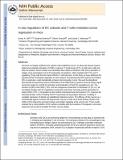| dc.contributor.author | Ali, Omar Abdel-Rahman | |
| dc.contributor.author | Emerich, Dwaine | |
| dc.contributor.author | Dranoff, Glenn | |
| dc.contributor.author | Mooney, David J. | |
| dc.date.accessioned | 2015-06-09T17:53:03Z | |
| dc.date.issued | 2009 | |
| dc.identifier.citation | Ali, O. A., D. Emerich, G. Dranoff, and D. J. Mooney. 2009. “In Situ Regulation of DC Subsets and T Cells Mediates Tumor Regression in Mice.” Science Translational Medicine 1 (8) (November 25): 8ra19–8ra19. doi:10.1126/scitranslmed.3000359. | en_US |
| dc.identifier.issn | 1946-6234 | en_US |
| dc.identifier.uri | http://nrs.harvard.edu/urn-3:HUL.InstRepos:16235677 | |
| dc.description.abstract | Vaccines are largely ineffective for patients with established cancer, as advanced disease requires potent and sustained activation of CD8\(^+\) cytotoxic T lymphocytes (CTLs) to kill tumor cells and clear the disease. Recent studies have found that subsets of dendritic cells (DCs) specialize in antigen cross-presentation and in the production of cytokines, which regulate both CTLs and T regulatory (Treg) cells that shut down effector T cell responses. Here, we addressed the hypothesis that coordinated regulation of a DC network, and plasmacytoid DCs (pDCs) and CD8\(^+\) DCs in particular, could enhance host immunity in mice. We used functionalized biomaterials incorporating various combinations of an inflammatory cytokine, immune danger signal, and tumor lysates to control the activation and localization of host DC populations in situ. The numbers of pDCs and CD8\(^+\) DCs, and the endogenous production of interleukin-12, all correlated strongly with the magnitude of protective antitumor immunity and the generation of potent CD8\(^+\) CTLs. Vaccination by this method maintained local and systemic CTL responses for extended periods while inhibiting FoxP3 Treg activity during antigen clearance, resulting in complete regression of distant and established melanoma tumors. The efficacy of this vaccine as a monotherapy against large invasive tumors may be a result of the local activity of pDCs and CD8\(^+\) DCs induced by persistent danger and antigen signaling at the vaccine site. These results indicate that a critical pattern of DC subsets correlates with the evolution of therapeutic antitumor responses and provide a template for future vaccine design. | en_US |
| dc.description.sponsorship | Engineering and Applied Sciences | en_US |
| dc.description.sponsorship | Other Research Unit | en_US |
| dc.language.iso | en_US | en_US |
| dc.publisher | American Association for the Advancement of Science (AAAS) | en_US |
| dc.relation.isversionof | doi:10.1126/scitranslmed.3000359 | en_US |
| dash.license | LAA | |
| dc.title | In Situ Regulation of DC Subsets and T Cells Mediates Tumor Regression in Mice | en_US |
| dc.type | Journal Article | en_US |
| dc.description.version | Accepted Manuscript | en_US |
| dc.relation.journal | Science Translational Medicine | en_US |
| dash.depositing.author | Mooney, David J. | |
| dash.waiver | 2009-11-02 | |
| dc.date.available | 2015-06-09T17:53:03Z | |
| dash.affiliation.other | Harvard Medical School | en_US |
| dc.identifier.doi | 10.1126/scitranslmed.3000359 | * |
| dash.contributor.affiliated | Ali, Omar Abdel-Rahman | |
| dash.contributor.affiliated | Dranoff, Glenn | |
| dash.contributor.affiliated | Mooney, David | |


